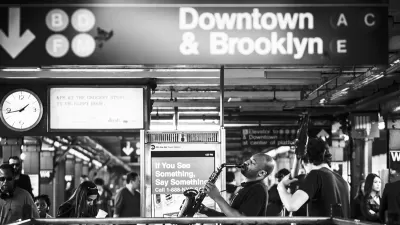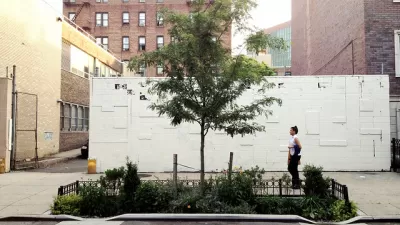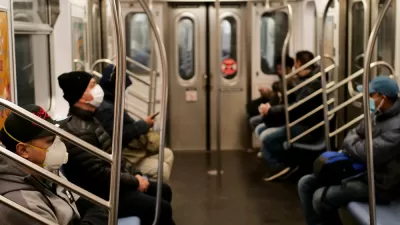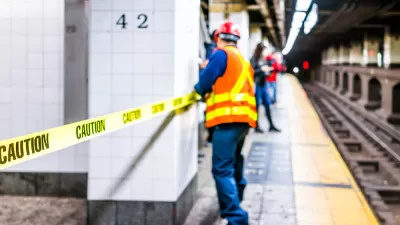While the New York subway's need for infrastructure investment is well documented, it was an improperly placed rail that caused two subway cars to derail on a southbound A train on Tuesday morning in Harlem.

The Metropolitan Transportation Authority "is now checking rails across the system to make sure replacement parts are being properly stored," report Jonathan Wolfe and Emma G. Fitzsimmons for The New York Times in one of several articles on the June 21 derailment.
The accident, which left at least 34 people injured [Planetizen put the number at 37] took place between the 135th Street and 125th Street stations. Two cars jumped the tracks after the emergency brakes were activated, officials said.
Human error was also the cause of a derailment almost two decades ago, on July 3, 1997, that occurred on the A Train line injuring 13 passengers and two firefighters.
A southbound A train jumped the track as it passed through 135th Street station at St. Nicholas Avenue. A worker who was fixing the switches at the station had accidentally flipped a switch for the wrong track.
The derailment added a new dimension to the concerns of the almost six million weekday commuters who rely on the nation's largest subway. "Until Tuesday, the main concern for riders had been long and unpredictable delays in a fraying system," report Fitzsimmons and Marc Santora in an earlier piece. "But in a flash, the concern shifted from inconvenience to questions about basic safety."
While human error was the cause of these two derailments, aging equipment in the 112-year-old system is causing delays plaguing every line. However, "it is not the No. 1 reason," report Fitzsimmons, Ford Fessenden, and K.K. Rebecca Lai in a related article.
The major cause of subway delays is a factor that basically did not exist 15 years ago: overcrowding. The subway is a victim of its own success and the city's resurgence. Large crowds slow down trains, which creates more crowding in a vicious circle that takes hours to unwind during every rush.
The article has a chart showing delays attributed to overcrowding, track maintenance, and signal failures or other track problems. The reporters chronicle the increase in subway ridership, which has reached "the highest level since the 1940s."
FULL STORY: New York Today: Derailment Answers and Your Commute

Study: Maui’s Plan to Convert Vacation Rentals to Long-Term Housing Could Cause Nearly $1 Billion Economic Loss
The plan would reduce visitor accommodation by 25,% resulting in 1,900 jobs lost.

North Texas Transit Leaders Tout Benefits of TOD for Growing Region
At a summit focused on transit-oriented development, policymakers discussed how North Texas’ expanded light rail system can serve as a tool for economic growth.

Using Old Oil and Gas Wells for Green Energy Storage
Penn State researchers have found that repurposing abandoned oil and gas wells for geothermal-assisted compressed-air energy storage can boost efficiency, reduce environmental risks, and support clean energy and job transitions.

Private Donations Propel Early Restoration of Palisades Playground
Los Angeles has secured over $1.3 million in private funding to restore the Pacific Palisades playground months ahead of schedule, creating a modern, accessible space that supports community healing after recent wildfires.

From Blight to Benefit: Early Results From California’s Equitable Cleanup Program
The Equitable Community Revitalization Grant (ECRG) program is reshaping brownfield redevelopment by prioritizing projects in low-income and environmental justice communities, emphasizing equity, transparency, and community benefits.

Planting Relief: Tackling Las Vegas Heat One Tree at a Time
Nevada Plants, a Las Vegas-based nonprofit, is combating the city’s extreme urban heat by giving away trees to residents in underserved neighborhoods, promoting shade, sustainability, and community health.
Urban Design for Planners 1: Software Tools
This six-course series explores essential urban design concepts using open source software and equips planners with the tools they need to participate fully in the urban design process.
Planning for Universal Design
Learn the tools for implementing Universal Design in planning regulations.
Ascent Environmental
Borough of Carlisle
Institute for Housing and Urban Development Studies (IHS)
City of Grandview
Harvard GSD Executive Education
Toledo-Lucas County Plan Commissions
Salt Lake City
NYU Wagner Graduate School of Public Service





























